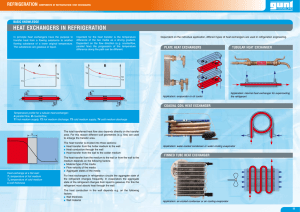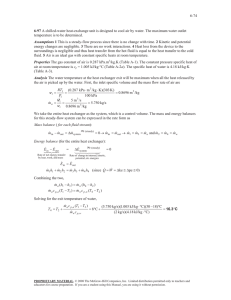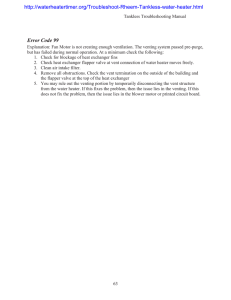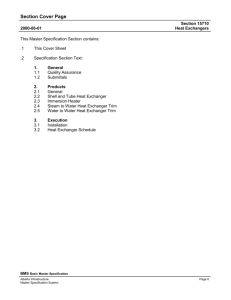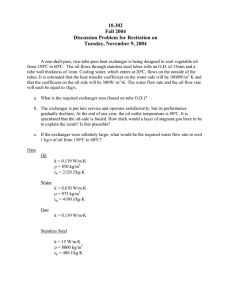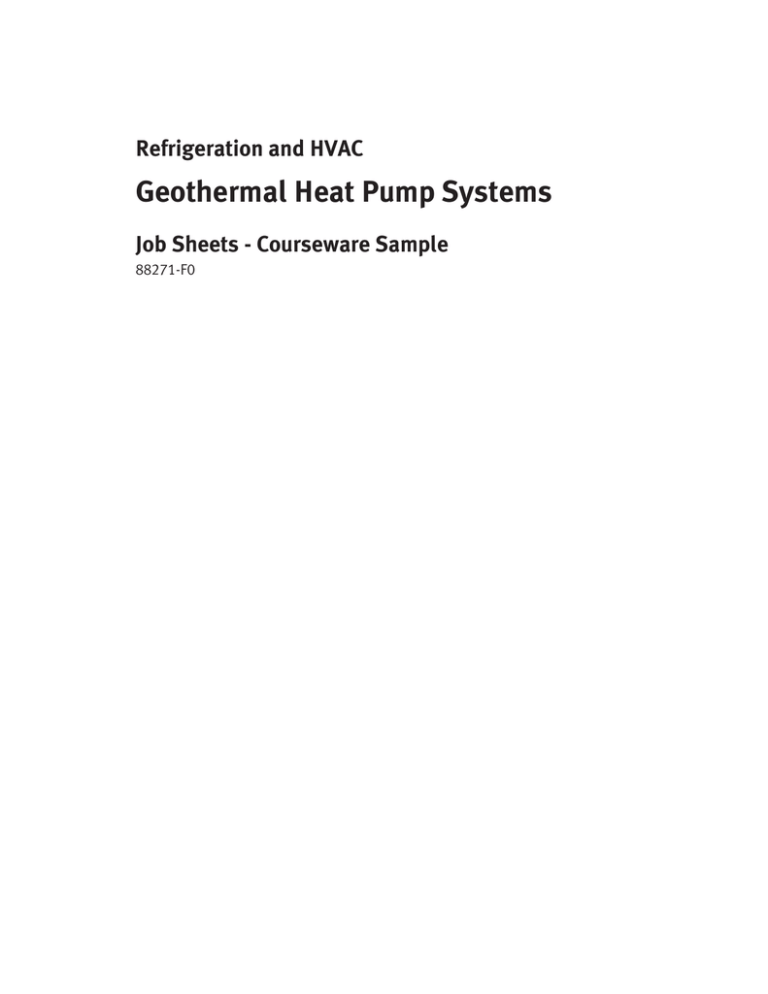
Refrigeration and HVAC
Geothermal Heat Pump Systems
Job Sheets - Courseware Sample
88271-F0
Order no.:
88271-30
Second Edition
Revision level: 04/2015
By the staff of Festo Didactic
© Festo Didactic Ltée/Ltd, Quebec, Canada 2012, 2013
Internet: www.festo-didactic.com
e-mail: did@de.festo.com
Printed in Canada
All rights reserved
ISBN 978-2-89640-786-6 (Printed version)
ISBN 978-2-89640-787-3 (CD-ROM)
Legal Deposit – Bibliothèque et Archives nationales du Québec, 2013
Legal Deposit – Library and Archives Canada, 2013
The purchaser shall receive a single right of use which is non-exclusive, non-time-limited and limited
geographically to use at the purchaser's site/location as follows.
The purchaser shall be entitled to use the work to train his/her staff at the purchaser's site/location and
shall also be entitled to use parts of the copyright material as the basis for the production of his/her own
training documentation for the training of his/her staff at the purchaser's site/location with
acknowledgement of source and to make copies for this purpose. In the case of schools/technical
colleges, training centers, and universities, the right of use shall also include use by school and college
students and trainees at the purchaser's site/location for teaching purposes.
The right of use shall in all cases exclude the right to publish the copyright material or to make this
available for use on intranet, Internet and LMS platforms and databases such as Moodle, which allow
access by a wide variety of users, including those outside of the purchaser's site/location.
Entitlement to other rights relating to reproductions, copies, adaptations, translations, microfilming and
transfer to and storage and processing in electronic systems, no matter whether in whole or in part, shall
require the prior consent of Festo Didactic GmbH & Co. KG.
Information in this document is subject to change without notice and does not represent a commitment on
the part of Festo Didactic. The Festo materials described in this document are furnished under a license
agreement or a nondisclosure agreement.
Festo Didactic recognizes product names as trademarks or registered trademarks of their respective
holders.
All other trademarks are the property of their respective owners. Other trademarks and trade names may
be used in this document to refer to either the entity claiming the marks and names or their products.
Festo Didactic disclaims any proprietary interest in trademarks and trade names other than its own.
Safety and Common Symbols
The following safety and common symbols may be used in this manual and on
the equipment:
Symbol
Description
DANGER indicates a hazard with a high level of risk which, if not
avoided, will result in death or serious injury.
WARNING indicates a hazard with a medium level of risk which,
if not avoided, could result in death or serious injury.
CAUTION indicates a hazard with a low level of risk which, if not
avoided, could result in minor or moderate injury.
CAUTION used without the Caution, risk of danger sign ,
indicates a hazard with a potentially hazardous situation which,
if not avoided, may result in property damage.
Caution, risk of electric shock
Caution, hot surface
Caution, risk of danger
Caution, lifting hazard
Caution, hand entanglement hazard
Notice, non-ionizing radiation
Direct current
Alternating current
Both direct and alternating current
Three-phase alternating current
© Festo Didactic 88271-30
III
Safety and Common Symbols
Symbol
Description
Earth (ground) terminal
Protective conductor terminal
Frame or chassis terminal
Equipotentiality
On (supply)
Off (supply)
Equipment protected throughout by double insulation or
reinforced insulation
In position of a bi-stable push control
Out position of a bi-stable push control
IV
© Festo Didactic 88271-30
Table of Contents
Preface ................................................................................................................. VII
About This Manual ................................................................................................ IX
To the Instructor .................................................................................................... XI
Job Sheet 1
Geothermal Energy .................................................................. 1
Job Sheet 2
The Ground Loop ................................................................... 27
Job Sheet 3
Heat Pump Connections and Interior Piping ...................... 53
Job Sheet 4
The Refrigeration Cycle ........................................................ 87
Job Sheet 5
Psychrometrics .................................................................... 117
Job Sheet 6
Geothermal Heat Pumps ..................................................... 145
Job Sheet 7
Heat Exchangers .................................................................. 165
Job Sheet 8
Heat Pump Control and Safety Devices ............................ 191
Job Sheet 9
System Characterization ..................................................... 239
Job Sheet 10
Maintenance and Troubleshooting .................................... 249
Job Sheet 11
Geothermal Software Design Tools ................................... 261
Appendix A
Conversion Table ................................................................. 281
Appendix B
Pressure-Enthalpy Diagrams.............................................. 283
Appendix C
Psychrometric Charts ......................................................... 285
Appendix D
Anemometer Instructions ................................................... 287
Appendix E
Thermo-Fusion Joints on Geothermal Pipes .................... 291
Appendix F
Priming Procedures ............................................................. 299
© Festo Didactic 88271-30
V
Table of Contents
Appendix G
Maintenance and Water Conditioning ............................... 301
Index................................................................................................................... 303
VI
© Festo Didactic 88271-30
Preface
Geothermal heat pump systems, also known as ground source heat pumps, are
among the most energy efficient systems available today for HVAC applications.
Depending on geographical location, typical energy savings from a geothermal
heat pump system are from 25% to 70%.
The Geothermal Training System, Model 46126, allows you to develop
knowledge in heat transfer, refrigeration, and air conditioning. The topics covered
in the job sheets are designed to help you gain the skills required during
installation, operation, and troubleshooting of geothermal heat pump systems.
The tools and instruments commonly used with geothermal heat pump systems
are also introduced and, when applicable, are used during hands-on activities.
We invite readers of this manual to send us their tips, feedback, and
suggestions for improving the book.
Please send these to did@de.festo.com.
The authors and Festo Didactic look forward to your comments.
© Festo Didactic 88271-30
VII
About This Manual
Description
The topics covered in this manual are presented in the form of job sheets. Each
job sheet consists of a theoretical section named Information Job Sheet followed
by a series of tasks required to attain the learning objectives.
Safety considerations
Safety symbols that may be used in this manual and on the equipment are listed
in the Safety Symbols table at the beginning of the manual.
Safety procedures related to the tasks that you will be asked to perform are
indicated in each exercise.
Make sure that you are wearing appropriate protective equipment when
performing the tasks. You should never perform a task if you have any reason to
think that a manipulation could be dangerous for you or your teammates.
Systems of units
Units are expressed using the International System of Units (SI) followed by the
units expressed in the U.S. customary system of units (between parentheses).
Appendices
The appendices included in this manual are:
Appendix A - Conversion Table: Factors to apply to convert US customary units
to SI units and vice versa.
Appendix B - Pressure-Enthalpy Diagrams: Pressure-enthalpy diagrams of the
refrigerant used in the training system.
Appendix C - Psychrometric Charts: Standard air psychrometric charts.
Appendix D - Anemometer Instructions: Operating
anemometer supplied with the training system.
instructions
of
the
Appendix E - Thermo-Fusion Joints on Geothermal Pipes: Explains how to make
joints on geothermal pipes.
© Festo Didactic 88271-30
IX
To the Instructor
You will find in this Instructor Guide all the elements included in the Student
Manual together with the answers to all questions, results of measurements,
graphs, explanations, suggestions, and, in some cases, instructions to help you
guide the students through their learning process. All the information that applies
to you is placed between markers and appears in red.
Accuracy of measurements
The numerical results of the hands-on exercises may differ from one student to
another. For this reason, the results and answers given in this manual should be
considered as a guide. Students who correctly performed the exercises should
expect to demonstrate the principles involved and make observations and
measurements similar to those given as answers.
Important note about the training system. The results obtained with the
geothermal training system correspond to a picture of the system when an
experiment was performed. Each experiment is done under conditions (ambient
temperature, temperature of the water in the tank, humidity…) which can vary
tremendously from a location to the other and as time goes by. Those operating
conditions have a large impact on the performance of the system as well as on
the measurements obtained and on the calculations based upon those
measurements. Consequently, the results given in this instructor manual are far
from absolute: they are merely examples of results and calculations. The
instructor must use care when interpreting the results herein and comparing them
to results obtained by his/her students. The intended phenomena and learning
objectives will be met, but numerical results will inevitably vary.
On the use of the digital thermometer. The digital thermometer provided with
your training system may feature two channels. If this is the case, it is a good
practice to use only a single channel (and always the same one) to perform the
temperature measurements. This ensures better precision of the temperature
measurements as the two channels may present different readings for a given
thermocouple at a given temperature. Also, the calculations often make use of
temperature differences. The accuracy is better if all readings come from the
same channel as there is then no risk of conflicting offsets from two channels.
The instructor should remind his students of this fact on a regular basis.
© Festo Didactic 88271-30
XI
Sample
Extracted from
the Job Sheets Student
and the Job Sheets Instructor
Information Job Sheet
7
Heat Exchangers
Heat exchangers
Introduction
Heat exchangers are devices that transfer energy from a warmer fluid to a
colder one. The role of the exchanger is to optimize the transfer of heat by
providing a space where the two fluids interact thermally as much as possible.
The fluids do not mix together during the heat exchange process due to a
physical barrier between them. The exchanger provides a surface area that
allows the heat of the hot fluid to be transferred by conduction to the cold fluid
through the thin, heat-conductive walls separating the fluids.
There are different devices that exchange heat that are not strictly considered
heat exchangers. In general, devices that mix two fluids at different temperatures
are considered mass and heat exchangers. Mixing chambers, such as a kitchen
faucet that mixes hot and cold water together, are a good example of such
devices. However, we will not discuss such exchangers in this manual.
The heat that is exchanged in a given fluid can be expressed by the following
equation:
ܳሶ ൌ ݉ሶܿ ሺܶ െ ܶ௨௧ ሻ
where
ܳሶ
is the heat flow of the fluid in W (Btu/h)
݉ሶ
is the mass flow rate of the fluid in kg/s (lbs/h)
ܿ
is the constant pressure specific heat of the fluid (e.g.,
4190 J/kg °C (1.00 Btu/lb °F) for water at room
temperature) in J/kg·K (Btu/lb·°F)
is the temperature of the fluid entering the heat
exchanger in °C (°F)
is the temperature of the fluid leaving the heat
exchanger in °C (°F)
ܶ
ܶ௨௧
a
(7-1)
The fluids in a heat exchanger could be identified by a sub-index such as: "r"
for the refrigerant, "w" for water, "h" for the hot fluid, and "c" the cold fluid. The
equation for the hot fluid in an exchanger would then become: ܳሶ ൌ
݉ሶ ܿǡ ൫ܶǡ െ ܶ௨௧ǡ ൯.
Configurations of heat exchangers are available for different applications. One of
the most common types of exchanger is the coaxial type shown in the bottom of
Figure 105. In this exchanger, the fluids travel on the same axis on parallel
trajectories. The coaxial type exchanger is used on your training system. Both
the desuperheater and the geothermal heat pump ground-loop water/refrigerant
heat exchanger are instances of coaxial exchangers.
© Festo Didactic 88271-30
165
Job Sheet 7 – Heat Exchangers
Another type of heat exchanger is called the cross-flow heat exchanger. In this
arrangement, instead of traveling in the same direction, both fluids meet at a
ninety degree angle. The air/refrigerant heat exchanger found at the air intake of
the heat pump is an example of a cross-flow exchanger.
Heat exchanger analysis
A heat exchanger analysis allows us to determine the amount of heat that is
transferred from one fluid to another. A thorough analysis also permits us to
determine the temperatures at the inlet and outlet of the fluids under certain
conditions.
In a coaxial heat exchanger, fluids exchange heat using one of two flow
configurations: the parallel-flow configuration (Figure 105a), where hot and cold
fluids enter on the same side of the exchanger, and the counter-flow
configuration (Figure 105b), where the fluids enter at opposite sides of the
exchanger.
The fluids continue to exchange heat as long as there is a temperature difference
between the fluids at a given position in the exchanger.
Hot fluid
Temperature
Temperature
Hot fluid
Cold fluid
Cold fluid
Position
Position
ܶ௨௧ ௗ
ܶ௨௧ ௧
ܶ௧
ܶௗ
ܶ ௧
ܶ௨௧ ௧
ܶ௨௧ ௗ
ܶௗ
(a)
(b)
Figure 105. Heat exchanger flow.
Figure 105 shows that, when the flows are parallel, the temperatures of the hot
and cold fluids merge until they either reach the same temperature or they exit
the exchanger. When the fluids are flowing in a counter-flow configuration, the
temperature lines have a tendency to "follow each other". Note that in the
counter-flow configuration, the output temperature of the hot fluid can be colder
than the output temperature of the cold water as shown in Figure 105b.
Several different heat exchangers play major roles in the geothermal heat pump
HVAC installations.
166
© Festo Didactic 88271-30
Job Sheet 7 – Heat Exchangers
x
The ground loop is a heat exchanger that transfers heat between the
thermal fluid and the ground.
x
The coaxial heat exchanger in the heat pump exchanges heat
between the ground loop and the refrigerant.
o
When the heat pump is set to work in heating mode, this
exchanger works as an evaporator. The refrigerant evaporates
as it takes the energy from the ground.
o
When the heat pump is working in cooling mode, the heat
exchanger works as a condenser. As the refrigerant transfers
heat to the ground, it is cooled and condensed into a liquid
during the process.
Refrigerant
Water
Refrigerant
Water
Figure 106. Coaxial heat exchanger.
x
The desuperheater heat exchanger is a counter-flow heat exchanger. It
exchanges heat from the refrigerant as it exits the compressor to the
water in a domestic hot water (DHW) tank.
x
The heat pump forced-air coil exchanges heat to warm the air when
heating is needed. It can also cool and dehumidify the air when air
conditioning is needed. In this case, the heat extraction cools the air and
condensates the water. The air cooling and the water condensation
have to be taken into account if an energy balance is performed.
The heat exchangers in a heat pump may work in counter-flow or parallel-flow
mode, depending on the mode of operation (heating or cooling mode).
The evaporator and condenser coils
When a change in matter occurs inside a heat exchanger, latent heat is
transferred. As long as only latent heat is exchanged, the fluid that condensates
or evaporates stays at the same temperature from the inlet to the outlet.
© Festo Didactic 88271-30
167
Job Sheet 7 – Heat Exchangers
Vapor in at T1
Liquid in at T3
Liquid out at T2
T3<T2<T1
Liquid out at T1
Figure 107. Condensation.
As shown in Figure 107, when condensation occurs in a heat exchanger, the
temperature of the condensing fluid remains constant; but its state changes from
vapor to liquid as it loses latent heat. The other fluid involved in the heat
exchange gains sensible heat and its temperature rises. The state of the second
fluid remains the same unless it reaches a state-change temperature (e.g., its
boiling point).
When a fluid condensates on one side of the heat exchanger, the fluid on the
other side absorbs heat and increases its temperature.
Condensing refrigerant
T
Heat flow
Fluid absorbing
heat
Position
Figure 108. Condensation.
On the other hand, when a fluid is boiling on one side of the evaporator, the fluid
on the other side cools down and releases energy.
168
© Festo Didactic 88271-30
Job Sheet 7 – Heat Exchangers
T
Hot fluid releasing
heat
Heat flow
Vaporizing refrigerant
Position
Figure 109. Vaporization.
In a typical heat pump, one of the flowing fluids is a refrigerant while the other
fluid is either simple water or a water/antifreeze solution. Heat exchangers may
work in parallel-flow or counter-flow and as either evaporators or condensers.
This versatility of the heat exchanger is possible by using different valves to
control the fluid flows. However, it makes this kind of heat exchangers more
difficult to understand and the calculations are slightly less tractable.
The heat flow entering (evaporation) or leaving (condensation) the fluid
undergoing a change of state is expressed by the equation:
ܳሶ ൌ ݉ሶ ή ݄
ܳሶ
݉ሶ
݄
where
a
(7-2)
is the heat flow in W (Btu/h)
is the mass flow rate of the fluid in kg/s (lb/h)
is the enthalpy of vaporization or condensation in
J/kg (Btu/lb)
The ݂ and ݃ indices in the ݄ variable refer to fluid and gas respectively. This
indicates that the enthalpy refers to the vaporization/condensation.
In a typical installation, the analysis of Equation (7-1) and Equation (7-2) must be
combined to reflect the multiple mechanisms at work in a geothermal heat
exchanger.
The effectiveness of a heat exchanger
The effectiveness of a heat exchanger can be calculated as:
߳ൌ
where
߳
ܳሶ
ܳሶ௫
© Festo Didactic 88271-30
ܳሶ
ሶ
ܳ௫
(7-3)
is the effectiveness, a dimensional number such that
Ͳ ߳ͳ
is the heat flow taking place in the exchanger in W (Btu/h)
is the maximum heat transfer possible for the fluid parameters in
W (Btu/h)
169
Job Sheet 7 – Heat Exchangers
The maximum amount of heat transfer occurs when the temperature of the hot
fluid drops to the temperature of the cold fluid at its inlet, or when the cold fluid
reaches the temperature of the hot fluid at its inlet.
To compare the amount of heat each fluid is handling, we need to calculate the
heat capacity of each fluid.
Formally, in SI units, the ܿ
would be expressed in units
of J/kgÂK, where K is the
Kelvin temperature unit.
This would imply the use of
temperatures in K instead of
°C in the equations in this
page. However, temperatures differences in °C and
K are the same, making this
distinction irrelevant to our
needs.
T [K] = T [°C] + 273.15
ܥ ൌ ݉ሶ ή ܿǡ
where
ܥ
݉ሶ
ܿǡ
(7-4)
is the cold fluid heat capacity rate in W/°C (Btu/h·°F)
is the mass flow rate of the cold fluid in kg/s (lb/h)
is the cold fluid specific heat in J/kg·°C (Btu/lb·°F)
ܥ ൌ ݉ሶ ή ܿǡ
where
ܥ
݉ሶ௧
ܿǡ
(7-5)
is the hot fluid heat capacity rate in W/°C (Btu/h·°F)
is the mass flow rate of the hot fluid in kg/s (lb/h)
is the hot fluid specific heat in J/kg·°C (Btu/lb·°F)
Keep the smallest value between ܥ and ܥ (ܥ ൌ ሺܥ ǡ ܥ ሻ) and replace it in
the following equation to obtain the maximum heat transfer:
ܳሶ௫ ൌ ܥǤ ൫ܶǡ െ ܶǡ ൯
where
ܳሶ௫
ܥǤ
ܶǡ
ܶǡ
(7-6)
is the maximum heat transfer possible in W (Btu/h)
is the minimum specific heat from the fluids in W/°C (Btu/h·°F)
is the temperature of the hot fluid entering the heat exchanger
in °C (°F)
is the temperature of the cold fluid entering the heat exchanger
in °C (°F)
The desuperheater
The desuperheater is a heat exchanger that extracts the sensible superheat
stored in the refrigerant after the compression process. In the geothermal heat
pump, the desuperheater is used to warm the water in a domestic hot water tank
(DHW). This "free" energy saves part of the electric work that would otherwise be
required to rise the water temperature in the tank.
The energy transferred to the water by the desuperheater is shown as a blue
segment in Figure 110.
170
© Festo Didactic 88271-30
Job Sheet 7 – Heat Exchangers
P (abs)
Superheat recovered by
the desuperheater
High pressure
Low pressure
݄
Figure 110. Desuperheater graph.
A double-tube heat exchanger is installed between the compressor exit and the
four-way valve to transfer the superheat to the domestic hot water tank.
The goal of this heat exchanger is to cool down the superheated refrigerant as it
exits the compressor to a temperature that is only slightly above the saturation
temperature.
Refrigerant in
Water out
Refrigerant out
Water in
Figure 111. Desuperheater.
The pump that circulates the water through the desuperheater should work only
when the temperature of the water in the tank is lower than the saturation
temperature. The refrigerant should transfer heat to the water, but the water
should never transfer heat to the refrigerant. If heat is transferred to the
refrigerant, the pressure increases at the compressor exit, making the system
less efficient.
In heating mode, the desuperheater circulation pump is usually turned off
allowing all the available heat to warm the house.
© Festo Didactic 88271-30
171
Job Sheet 7 – Heat Exchangers
Thermal efficiency
The ratio between the heat output and the heat input of any device is the
theoretical thermal efficiency.
ߟ௧ ൌ
ܳ௨௧
ܳ
(7-7)
From the first law of thermodynamics, the energy output of a closed system
cannot exceed its input. Consequently, the thermal efficiency is always in the
range between:
Ͳ ߟ௧ ͳ
When expressed as a percentage, the thermal efficiency must be between 0%
and 100%. Due to inefficiencies, such as friction, heat loss, and other factors, the
efficiency of any real-world thermal engine is typically much less than 100%.
172
© Festo Didactic 88271-30
Job Sheet
7
Heat Exchangers
OBJECTIVES
In this job sheet, you will determine the refrigerant mass flow rate circulating in
the heat pump. You will also calibrate the water flow in the desuperheater to heat
water in the domestic hot water tank (DHW) using the sensible heat from the hot,
superheated refrigerant. You will determine the amount of money that could be
saved with the use of a desuperheater.
PROCEDURE
1. Perform the following settings on your training system.
Main power switch ............................................................................. Off
Thermostat ........................................................................ Heating mode
Temperature set point ....................... 5°C (9°F) above room temperature
Valve HV-1 ......................................................................................Open
Valve HV-2 ......................................................................................Open
Valve HV-3 ......................................................................................Open
Valve HV-4 ......................................................................................Open
Valve HV-5 ......................................................................................Open
Valve HV-6 ......................................................................................Open
Valve HV-7 ......................................................................................Open
Valve HV-8 ................................................................................... Closed
Valve HV-9 ........................................................ No adjustments required
Valve HV-10 ................................................ Handle in horizontal position
Valve HV-11 ....................................................................................Open
Valve HV-12 ....................................................................................Open
Valve HV-13 ....................................................................................Open
Pressure gauge PI-1 selector switch ............................................... Right
Pressure gauge PI-2 selector switch ............................................... Right
Desuperheater On/Off switch ............................................................ On
Priming tank three-way valves .....................................................
Pumping station three-way valves .............................................
Air distribution register ....................................................................Open
2. Set the main power switch to On.
3. Turn the valve HV-10 to the vertical position.
© Festo Didactic 88271-30
173
Job Sheet 7 – Heat Exchangers
4. When the desuperheater indicator light turns on, adjust valve HV-9 to obtain
a flow (FI-4) of 2 L/min (0.6 gal/min).
5. Locate the desuperheater heat exchanger on your training system. Complete
Table 27 using the following labels: Refrigerant out, Water in, Water out, and
Desuperheater pump.
D
C
E
B
A
Figure 112. Desuperheater.
Table 27. Desuperheater element identification.
Location
Name
A
B
C
Refrigerant in
D
E
a
The domestic hot water tank of your training system has a capacity of 9.5 L
(2.5 gal).
Desuperheater element identification.
Location
174
Name
A
Refrigerant out
B
Water in
C
Refrigerant in
D
Desuperheater pump
E
Water out
© Festo Didactic 88271-30
Job Sheet 7 – Heat Exchangers
6. What type of configuration (parallel-flow or counter-flow) is used for the heat
exchanger of the desuperheater?
The heat exchanger
configuration.
of
the
desuperheater
uses
the
counter-flow
7. Turn valve HV-10 to the horizontal position.
8. Measure the temperatures and pressures shown in Table 28. Wait for fifteen
minutes and repeat your measurements. Complete Table 28.
Table 28. Domestic hot water data.
࢚
࢚
ࢀࢀିૡ
ࢀࢀିૢ
ࢀࢀି
ࢀࢀି
ࢀࢀି
ࢀࢀି
LP
HP
DHW data (SI units).
࢚
© Festo Didactic 88271-30
࢚
ࢀࢀିૡ (°C)
8.5
3.4
ࢀࢀିૢ (°C)
67.4
69.7
ࢀࢀି (°C)
42.1
46.9
ࢀࢀି (°C)
32.9
31.1
ࢀࢀି (°C)
21.4
36.5
ࢀࢀି (°C)
26.5
39.4
LP (bar)
8.3
7.0
HP (bar)
24.0
24.0
175
Job Sheet 7 – Heat Exchangers
DHW data (US customary units).
࢚
࢚
ࢀࢀିૡ (°F)
47
40
ࢀࢀିૢ (°F)
130
153
ࢀࢀି (°F)
109
111.6
ࢀࢀି (°F)
95.8
89.3
ࢀࢀି (°F)
68.6
89.7
ࢀࢀି (°F)
87.7
95.9
LP (psia)
125
110
HP (psia)
350
375
9. Using a pressure-enthalpy diagram included at the end of this job sheet, find
the saturation temperature ܶ௦௧ for the value of HP found after fifteen minutes
(remember that HP is a gauge pressure).
Saturation temperature ܶ௦௧ : _______
Saturation temperature (ܶ௦௧ ): 40°C (115°F)
10. Turn valve HV-10 to the vertical position and let the water run for one minute.
Turn valve HV-10 to the horizontal position and measure TC-10.
Temperature measured by TC-10: _______
Temperature measured at TC-10: 46.9°C (111.6°F)
The temperature must be adjusted to 42°C (119°F) for the operating
conditions of the system given in this example. Results may vary.
11. Next, adjust valve HV-9 to obtain a temperature measured by TC-10 that is
2°C (4°F) over the saturation temperature found in step 0.
Set the thermostat operating mode to Off.
176
© Festo Didactic 88271-30
Job Sheet 7 – Heat Exchangers
12. Calculate the energy gained by the water from ݐ to ݐଵହ using
Equation (7-8) and the temperatures measured at TC-15:
ܳ ൌ ݉௪ ܿǡ௪ ሺܶଵହ െ ܶ ሻ
where
ܳ
݉௪
ܿǡ௪
ܶଵହ
ܶ
(7-8)
is the heat gained by the water in J (Btu)
is the mass of water in kg (lb)
A 9.5 liter (2.5 gallon) water heater corresponds to 9.5 kg
(20.875 lb) of water.
is the constant pressure specific heat of water in J/kg·°C
(Btu/lb·°F)
is the temperature of the water after fifteen minutes of
running the system in °C (°F)
is the temperature of water at the beginning of the
experiment in °C (°F)
SI units
ܳ = 9.5 × 4.18 × (36.5 - 21.4) = 599.6 kJ
US customary units
ܳ = 20.875 × 1.0 × (89.7 - 68.6) = 440.5 Btu
13. The heat flow rate of the process corresponds to the total heat gained by the
water in the tank (calculated at step 12) divided by the number of seconds in
fifteen minutes or 0.25 hours.
ܳሶ௪ ൌ
where
ܳሶ௪
ܳ௪
ݐ
ܳ௪
ݐ
(7-9)
is the heat flow rate in W (Btu/h)
is the total heat gained by water in J (Btu)
is the time elapsed in seconds (SI units) or hours (US units)
Calculate the heat flow rate of the process:
SI units
Heat flow rate of the process = ܳሶ ൌ
ହଽଽǤ୩
ଵହ ୫୧୬ ൈୱȀ୫୧୬
ൌ
ହଽଽǤ
ଽ
ൌ ͲǤ
US customary units
Heat flow of the process = ܳሶ ൌ
© Festo Didactic 88271-30
ସସǤହ୲୳
Ǥଶହ୦
ൌ ͶͶͲǤͷ ൈ Ͷ ൌ1762 Btu/h
177
Job Sheet 7 – Heat Exchangers
14. Plot the compression cycle in a pressure-enthalpy diagram (Figure 117 or
Figure 118) and fill in Table 29.
Table 29. Temperature-enthalpy.
Enthalpy
TC–915 min
TC–1015 min
The compression cycle is given in the graph below.
P (abs)
TC-11
TC-10
TC-9
High pressure
Low pressure
TC-8
݄
Compression cycle.
Table 29. Temperature-enthalpy (SI units).
Enthalpy
(kJ/kg)
TC – 915 min
470
TC – 1015 min
438
Table 29. Temperature-enthalpy (US customary units).
Enthalpy
(Btu/lb)
178
TC – 915 min
136
TC – 1015 min
123
© Festo Didactic 88271-30
Job Sheet 7 – Heat Exchangers
15. Locate the TC-10 point on the pressure-enthalpy diagram. Is the
desuperheater working in its ideal range of operation? Why?
No. To be in its ideal range, the desuperheater should operate in such a way
that the TC-10 point is located precisely on the boundary of sensible enthalpy
for the gaseous state. The actual position of TC-10 is slightly to the right of
the boundary.
16. What would be the effect on the temperature read by TC-10 if you were to
modify the desuperheater flow rate?
Increasing the flow rate into the desuperheater would move the TC-10 point
to the left to the boundary and into the latent enthalpy region of the cycle.
Decreasing the flow rate would move the TC-10 point to the right, leaving
more heat available to heat the room.
17. Explain why it is preferable that the temperature at TC-10 does not drop
below the saturation temperature?
If TC-10 drops below the saturation pressure, too much heat is transferred to
the DHW. This does not have much impact if the system is in cooling mode.
However, in heating mode, the system may simply be unable to heat the
house as needed.
18. To calculate the refrigerant mass flow that circulates, compare the heat flow
absorbed by the water with the enthalpy difference corresponding to the
temperatures ܶ ܥെ ͻଵହ and ܶ ܥെ ͳͲଵହ .
݉ሶ ൌ
ܳሶ௪
݉ሶ
where
݄ ்ିଵ
݄ ்ିଽ
ܳሶ௪
ሺ݄ ்ିଽ െ ݄ ்ିଵ ሻ
(7-10)
is the water heat flow in W (Btu/h) measured in step 13
is the refrigerant mass flow rate in kg/s (lbs/h)
is the enthalpy corresponding to TC-10 in J/kg (Btu/lb)
is the enthalpy corresponding to TC-9 in J/kg (Btu/lb)
SI units
݉ሶ ൌ ொሶೢ
ሺషవ ିషభబ ሻ
ൌ
Ǥ
ସିସଷ଼
ൌ ͲǤͲʹͲͺ kg/s
US customary units
݉ሶ ൌ © Festo Didactic 88271-30
ொሶೢ
ሺషవ ିషభబ ሻ
ൌ
ଵଶ
ଵଷିଵଶଷ
ൌ ͳ͵ͷǤͷ lb/hour
179
Job Sheet 7 – Heat Exchangers
19. Calculate the amount of money the desuperheater saves in heating costs for
one hour of continuous work. Assume one kWh costs $0.08 (U.S.).
bElectric work (W ሻ ൌ ݉ሶ ሺ்݄ିଽ െ ்݄ିଵሻ ൌ ܳሶ௪ Ǥ
e
SI units
ܹ ൌ ܳሶ௪ ൌ ͲǤ kW
Savings = ͲǤ ൈ ͲǤͲͺ
̈́
୩୦
ൌ0.053 $ per hour
US customary units
ܹ ൌ ܳሶ௪ ൌ ͳʹ Btu/h = 1762 Btu/h ÷ 3.413 Btu/hÂW = 0.516 kW
Savings = ͲǤͷͳ ൈ ͲǤͲͺ
180
̈́
୩୦
ൌ0.041 $ per hour
© Festo Didactic 88271-30
Job Sheet 7 – Heat Exchangers
Coaxial coil heat exchanger
The following exercise is optional and explores the characteristics of the heat
pump coaxial heat exchanger. You will calculate the refrigerant mass flow using
the coaxial heat exchanger in heating mode and in cooling mode. You will also
determine how the heat exchanger works in each mode.
20. Perform the following adjustments to the settings of your training system.
Main power switch ............................................................................. On
Thermostat ........................................................................ Heating mode
Temperature set point ....................... 5°C (9°F) above room temperature
Valve HV-1 ......................................................................................Open
Valve HV-2 ......................................................................................Open
Valve HV-3 ......................................................................................Open
Valve HV-4 ......................................................................................Open
Valve HV-5 ......................................................................................Open
Valve HV-6 ......................................................................................Open
Valve HV-7 ......................................................................................Open
Valve HV-8 ................................................................................... Closed
Valve HV-9 ........................................................ No adjustments required
Valve HV-10 ................................................ Handle in horizontal position
Valve HV-11 ....................................................................................Open
Valve HV-12 ....................................................................................Open
Valve HV-13 ....................................................................................Open
Pressure gauge PI-1 selector switch ............................................... Right
Pressure gauge PI-2 selector switch ............................................... Right
Desuperheater On/Off switch ............................................................ Off
Priming tank three-way valves .....................................................
Pumping station three-way valves .............................................
Air distribution register ....................................................................Open
© Festo Didactic 88271-30
181
Job Sheet 7 – Heat Exchangers
21. Allow your training system to run for ten minutes. Complete Table 30.
Table 30. Temperature, pressure, and flow in heating mode.
ࢀࢀିૡ
ࢀࢀି
ࢀࢀି
ࢀࢀି
LP
Ground loop water flow
Temperature, pressure, and flow in heating mode (SI units).
ࢀࢀିૡ (°C)
16
ࢀࢀି (°C)
14.2
ࢀࢀି (°C)
22.1
ࢀࢀି (°C)
18.4
LP (bar)
10.6
Ground loop water flow (L/min)
11
Temperature, pressure, and flow in heating mode (US customary units).
ࢀࢀିૡ (°F)
60.8
ࢀࢀି (°F)
57.6
ࢀࢀି (°F)
71.8
ࢀࢀି (°F)
65.1
LP (psi)
154
Ground loop water flow (gal/min)
2.9
22. Fill in the blanks with your temperature readings and draw arrows to show
the fluid flow in Figure 113.
T=
T=
T=
T=
Figure 113. Heating mode heat exchanger analysis.
182
© Festo Didactic 88271-30
Job Sheet 7 – Heat Exchangers
T = 16°C
T = 14.2Ԩ
T = 18Ԩ
T = 22Ԩ
Heating mode heat exchange analysis.
Temperature
23. Plot a simple graph to show how the temperature of each fluid varies as they
flow through the system (as shown in Figure 109).
Position
TC-8, TC-13
TC-12, TC-14
Figure 114. Heat exchanger temperature tendency in heating mode.
© Festo Didactic 88271-30
183
Job Sheet 7 – Heat Exchangers
The evolution of the temperature looks like this in the exchanger:
Temperature
Water in
10
0.8
Water out
Refrigerant out
Refrigerant in
Position
TC-8, TC-13
TC-12, TC-14
Heat exchanger temperature tendency in heating mode.
24. In heating mode, does the heat exchanger work in parallel-flow or counterflow mode?
The heat exchanger works in counter-flow mode.
25. Is the heat exchanger working as an evaporator or a condenser?
The heat exchanger works as an evaporator.
184
© Festo Didactic 88271-30
Job Sheet 7 – Heat Exchangers
26. Perform the following adjustments to your training system.
Main power switch ............................................................................. On
Thermostat ........................................................................ Cooling mode
Temperature set point ....................... 5°C (9°F) below room temperature
Valve HV-1 ......................................................................................Open
Valve HV-2 ......................................................................................Open
Valve HV-3 ......................................................................................Open
Valve HV-4 ......................................................................................Open
Valve HV-5 ......................................................................................Open
Valve HV-6 ......................................................................................Open
Valve HV-7 ......................................................................................Open
Valve HV-8 ................................................................................... Closed
Valve HV-9 ........................................................ No adjustments required
Valve HV-10 ................................................ Handle in horizontal position
Valve HV-11 ....................................................................................Open
Valve HV-12 ....................................................................................Open
Valve HV-13 ....................................................................................Open
Pressure gauge PI-1 selector switch ............................................... Right
Pressure gauge PI-2 selector switch ............................................... Right
Desuperheater On/Off switch ............................................................ Off
Priming tank three-way valves .....................................................
Pumping station three-way valves .............................................
Air distribution register ....................................................................Open
© Festo Didactic 88271-30
185
Job Sheet 7 – Heat Exchangers
27. Allow your training system to run for ten minutes. Complete Table 31.
Table 31. Temperature, pressure, and flow in cooling mode.
ࢀࢀି
ࢀࢀି
ࢀࢀି
ࢀࢀି
HP
Ground loop water flow
Cooling mode (SI units).
ࢀࢀି (°C)
35.2
ࢀࢀି (°C)
32.9
ࢀࢀି (°C)
28.6
ࢀࢀି (°C)
32.2
HP (bar)
20
Ground loop water flow (L/min)
11
Cooling mode (US customary units).
186
ࢀࢀି (°F)
95.4
ࢀࢀି (°F)
91.2
ࢀࢀି (°F)
83.5
ࢀࢀି (°F)
90.0
HP (psi)
290
Ground loop water flow (gal/min)
2.9
© Festo Didactic 88271-30
Job Sheet 7 – Heat Exchangers
28. Set the thermostat operating mode to Off.
29. Complete the next figure by filling the measured temperatures in the blanks
and draw arrows to show the fluid flows.
T=
T=
T=
T=
Figure 115. Cooling mode heat exchange analysis.
T = 35.2Ԩ
T = 32.9Ԩ
T = 28.6Ԩ
T = 32.2Ԩ
Cooling mode heat exchange analysis.
Temperature
30. Plot a simple graph to show the drop in temperature as the fluid progresses
in the heat exchanger (Use Figure 108 as a reference).
Position
TC-10, TC-13
TC-12, TC-14
Figure 116. Heat exchanger temperature tendency in cooling mode.
© Festo Didactic 88271-30
187
Job Sheet 7 – Heat Exchangers
The evolution of the temperature looks like this in the exchanger:
Refrigerant in
Temperature
Refrigerant out
Water out
Water in
28
0.8
Position
TC-10, TC-13
TC-12, TC-14
Heat exchanger temperature tendency in cooling mode.
31. In cooling mode, does the heat exchanger work in parallel-flow or counterflow mode?
The heat exchanger works in parallel-flow mode.
32. Set the main power switch to Off.
188
© Festo Didactic 88271-30
Job Sheet 7 – Heat Exchangers
Figure 117. Pressure enthalpy diagram, SI units.
© Festo Didactic 88271-30
189
Job Sheet 7 – Heat Exchangers
Figure 118. Pressure enthalpy diagram, English units.
Name: _______________________________ Date: ____________________
Instructor's approval: ______________________________________________
190
© Festo Didactic 88271-30

